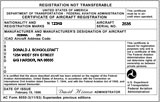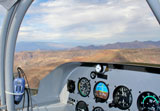|
Experimental Research and Development, Showing Compliance with Regulations, Crew Training, Market Surveys, and Kit-Built Certifications and OperationsGeneral InformationExperimental Research and Development aircraft - are defined as aircraft that test new design concepts, aircraft equipment, installations, operating techniques, or new uses for aircraft. Show compliance aircraft - are defined as aircraft that conduct flight tests and other operations to show compliance with the regulations. This includes flights to show compliance for the issuance of type and STCs, major design changes, and function and reliability requirements. Crew training aircraft - are defined as aircraft involved in the training of the applicant’s flight crews. Market survey aircraft - are defined as aircraft that are used for conducting market surveys, sales demonstrations, and customer crew training as provided for in FAR 21.195. Operating kit-built aircraft - is defined as operation of a primary category aircraft that meets the criteria of FAR 21.24(a)(1) that was assembled by a person from a kit manufactured by the holder of a production certificate (PC) for that kit, without the supervision and quality control of the PC holder under FAR 21.184(a). RESEARCH AND DEVELOPMENT Any aircraft would be eligible for an experimental certificate under this purpose. Although the operations may eventually lead to a Type Certificate (TC), they may be conducted by the applicant only as a matter of research or to determine whether an idea warrants further development. In addition to the operations specified in FAR 21.191(a), the operation of a chase plane, a tanker used for in-flight icing tests, or other aircraft not otherwise eligible for a standard or an experimental certificate (R&D), but necessary for use in direct connection with the R&D project, is considered to be within the scope of this purpose. Aircraft currently certificated in the experimental category for the purposes of exhibition or air racing also may be eligible for a special airworthiness certificate for the experimental purpose of R&D. Also, former military aircraft are often used in R&D projects. SHOWING COMPLIANCE WITH REGULATIONS This purpose would be considered valid when the applicant for a Type Certificate (TC) or an aircraft modifier has revised the TC design data or has applied for an Supplemental Type Certificate (STC) or field approval. The purpose is to show compliance to the CFR after the applicant has completed testing under R&D, if applicable, and has completed flight testing by the FAA. In addition to the operations specified in FAR 21.191(b), the operation of a chase plane or other aircraft not otherwise eligible for a standard or experimental certificate, but necessary for use in direct connection with a type certification project, is considered to be within the scope of this purpose. CREW TRAINING This purpose is limited to only the applicant’s flightcrews, which normally would be the manufacturer’s employees necessary to be trained in experimental aircraft. These flightcrews operate aircraft being flight tested in type certification programs or for production flight testing. MARKET SURVEYS A U.S. manufacturer of aircraft or engines and persons that alter aircraft may apply for a special airworthiness certificate in the experimental category for the purpose of market surveys, sales demonstrations, and customer crew training under FAR 21.195. Amateur-built aircraft kit manufacturers also may be eligible to give customer familiarization training under FAR 21.191(f). The FAA/DAR will ensure that the provisions of FAR 21.195 are met before issuing the experimental certificate. The applicant must provide the FAA representative with the estimated time or number of flights required for the market survey operation as well as the area or itinerary over which the operations are to be conducted. The duration of the certificate will be limited to the time needed for the described operations, normally not to exceed 90 days. A longer duration may be provided for a Production Certificate (PC) / Approved Production Inspection System (APIS) holder who has an approved procedure for experimental operations. The Manufacturing Inspection District Office (MIDO) manager has the option to extend the duration for other situations. OPERATING KIT BUILT AIRCRAFT If a primary category aircraft kit is assembled without the benefit of the PC holder’s supervision, the aircraft may qualify for an experimental certificate in accordance with FAR 21.191(h). The purchaser or owner of the kit is not required to assemble or fabricate any specific portion of the kit; assistance for some or all of the work may be obtained from other sources, such as the PC holder or some other fabricator. The kit, however, must have been manufactured by a PC holder. MANUFACTURERS AND MODIFIERS EXPERIMENTAL OPERATING PROCEDURES Production Certificate (PC) / Approved Production Inspection System (APIS) holders and modifiers may submit to their local managing office for FAA approval a procedure describing the operation of experimental aircraft. After it is approved, the procedure may be listed in the operating limitations. The FAA principal inspector (PI) may exclude certain aircraft from the privileges of either all or part of this procedure, for example, the first of a model, such as the B757/B767, or a nonproduction R&D aircraft. The procedure should include at least the following elements: - A description of the test area that will be used to show compliance with FAR 91.319(b). This area will be described by a radius, coordinates, and/or landmarks, and be over open water or sparsely populated areas having light air traffic. The size of the area will be that required to safely conduct the anticipated maneuvers and tests. Multiple-purpose certificates may require individually prescribed geographical areas. - A daily flight log that will be maintained by the pilot that shows compliance with FAR 91.319(b) and inspection of the aircraft prior to release for flights in the expanded test area. The flight log will be maintained for the duration of the certificate for review by the PI. - A description of the method used to conduct and record necessary flights outside the test area, and for maintaining these records. This procedure will remain active for the duration of the certificate, and will eliminate the need for the PC/APIS holder to obtain approval for each flight. - A description of the method used to define the persons who may be carried during these operations. The following must also be incorporated into the procedure: - A requirement that the pilot in command advise each passenger of the experimental nature of the aircraft, in accordance with FAR 91.319(d). - A method of recording persons carried on each flight. These records must be maintained for the duration of the certificate for review by the PI. - A provision that no persons may be carried in the aircraft during flight unless that person is required for the purpose of the flight. Persons other than flight crew members may be carried when all of the following conditions are met: a) the aircraft is of the same basic model that previously has shown compliance with FAR's 91.319(b) and 21.195; b) the aircraft has been proven to be safe; flight tests do not include intentional maneuvers involving abrupt changes in the aircraft’s attitude, abnormal attitudes, or abnormal acceleration/deceleration not necessary for normal flight; c) the procedures specifically cover the types of flying to be permitted while carrying passengers other than flight crew members; and d) the following placard is displayed inside the aircraft, in letters at least three-eighths of an inch high and in a location easily visible and legible to all persons entering the aircraft “NOTICE: THIS AIRCRAFT DOES NOT COMPLY WITH FEDERAL SAFETY REGULATIONS FOR STANDARD AIRCRAFT." - A description of the method used to determine that the aircraft is in a condition appropriate for the purpose intended when changing from one purpose to another (multiple-purpose certificates), and to document the results of this determination in a log or daily flight sheet (for example, changing from R&D to market survey). - Any other condition deemed necessary in the interest of safety by the PI. - A requirement that a copy of this procedure must be carried in the aircraft while operating under the privileges of this procedure. A copy of this procedure also may be included or directly referenced in the PC/APIS holder’s quality manual for the convenience of the manufacturer and the PI. Any enforcement deemed appropriate would be under FAR 91.319 and not FAR 21, Subpart F, Production Under Type Certificate Only, or Subpart G, Product Certificate. Click on the following link to see an example of the operating limitations the FAA/DAR will issue:
|









